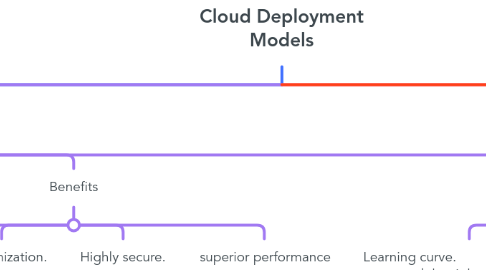
1. Public
1.1. use cases for public cloud:
1.1.1. *build secondary infrastructures for disaster recovery
1.1.2. *IT departements outsourcing the less critical and standarized buissnesses and applications to public cloud providers
1.1.3. * let organizations that are opting to access cloud-based appliccations so their team focus on building and testing
1.2. Benefits
1.2.1. Easy to manage
1.2.2. Cost.
1.2.3. Performance and reliability
1.2.4. infinite scalibility
1.3. Disadvantages
1.3.1. Less control.
1.3.2. Privacy and security
1.3.3. Simple Environments
1.3.4. governance issues
1.3.5. potential latency
2. Private
2.1. use cases for private cloud:
2.1.1. Operated solely and dedicated to an organization so no comingling of data or sharing resources resources isolation
2.1.2. Governance or Regulatory Requirements In other cases, security or governance issues force organizations into using a private cloud
2.1.3. Network Latency If your users are in an area distant from a public cloud provider, latency could slow down access to your application and make a private cloud a better option
2.2. Benefits
2.2.1. Increased control
2.2.2. Customization.
2.2.3. Highly secure.
2.2.4. superior performance
2.3. Disadvantages
2.3.1. Learning curve. you need the right technical skills. Developers, cyber security experts, and DevOps professionals
2.3.2. Cost.
2.3.3. underutilization
3. Community
3.1. use cases for community cloud:
3.1.1. This deployment model supports multiple organizations sharing computing resources that are part of a community; examples include universities cooperating in certain areas of research, or police departments within a county or state sharing computing resources. Access to a community cloud environment is typically restricted to the members of the community.
3.2. Benefits
3.2.1. Cost Savings
3.2.2. Security between tenants.
3.2.3. Enhanced collaboration.
3.3. Disadvantages
3.3.1. Technical requirements.
3.3.2. Data isolation
3.3.3. Rarity.
3.3.4. poor scalability
4. Hybrid
4.1. use cases for hybrid cloud:
4.1.1. Many organizations make use of this model when they need to scale up their IT infrastructure rapidly, such as when leveraging public clouds to supplement the capacity available within a private cloud
4.1.2. Data and AI integration
4.2. Benefits
4.2.1. Flexibility.
4.2.2. Scalability.
4.2.3. fewer it overheads
4.3. Disadvantages
4.3.1. Cost.
4.3.2. Data silos. you have to make sure that all of your data has been properly separated.
4.3.3. compatibity
